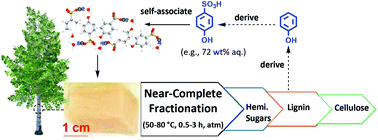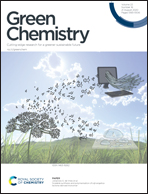The fractionation of woody biomass under mild conditions using bifunctional phenol-4-sulfonic acid as a catalyst and lignin solvent†
Abstract
The complete and mild-condition fractionation of woody biomass without energy-intensive size reduction still remains a significant challenge. This study reports an innovative cellulose-centred fractionation process based on bifunctional, recyclable, inexpensive, and lignin-derivable phenol-4-sulfonic acid (PSA). The results showed that aqueous PSA solution (e.g., 72 wt%) near-completely fractionated centimetre-sized hardwood, such as poplar and birch chips, into cellulose fibres of high quality (length: >1 mm, crystallinity index: 61–65, DPv: 830–887), fermentable hemicellulose sugars, and lignin in theoretical maximum yields under mild conditions (e.g., 50–80 °C, 0.5–3 h, atm). Calculations and experimental results suggest that PSA, as a small amphiphile, could form aggregates and clusters in water. Therefore, during fractionation, PSA acted as not only a selective catalyst through the immobilized sulfonic acid groups to depolymerize hemicellulose and lignin, but also as a mesoscale solvent to solubilize and protect lignin fragments through aggregates and accumulating around them due to the hydrophobic effect.



 Please wait while we load your content...
Please wait while we load your content...